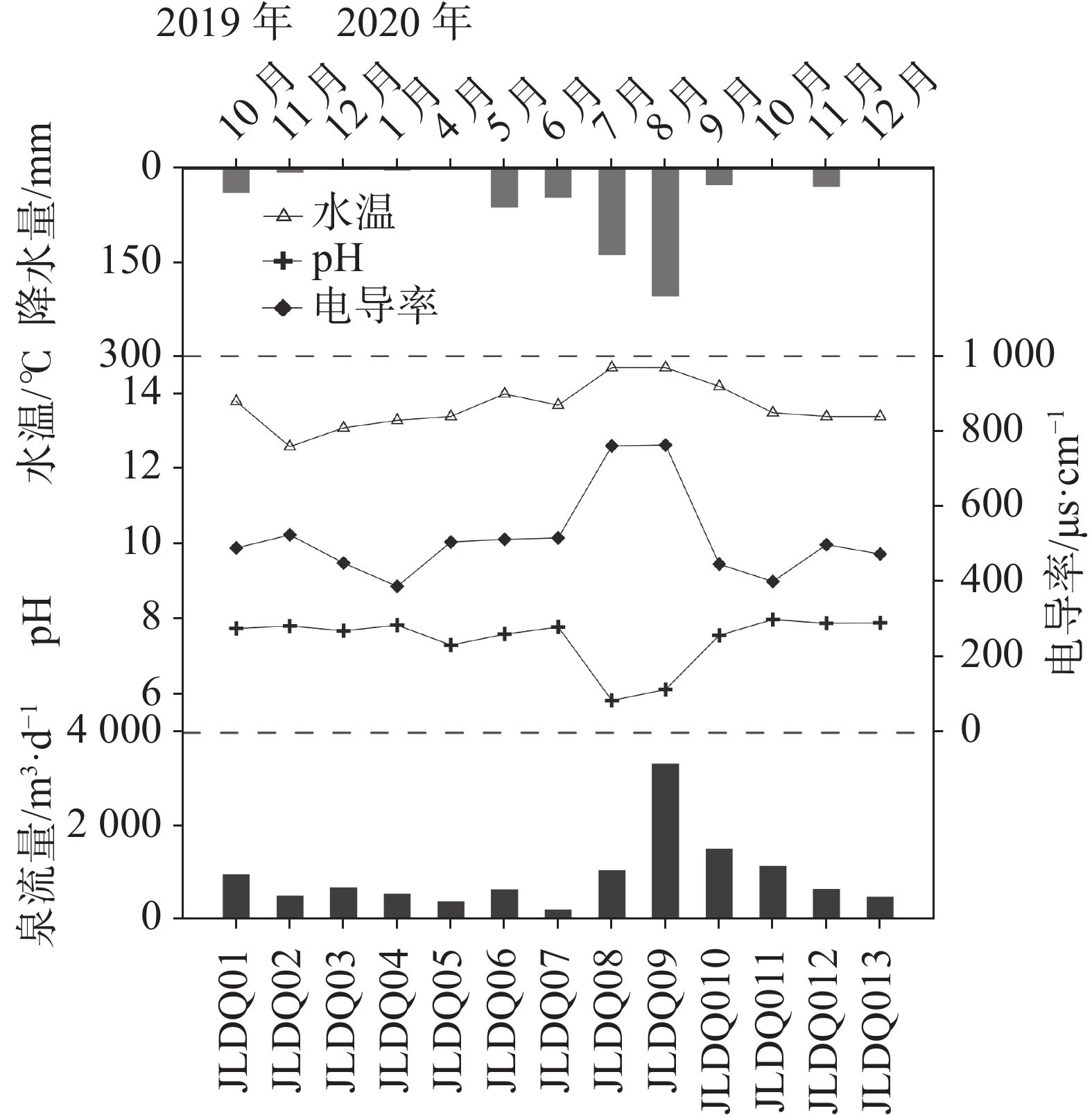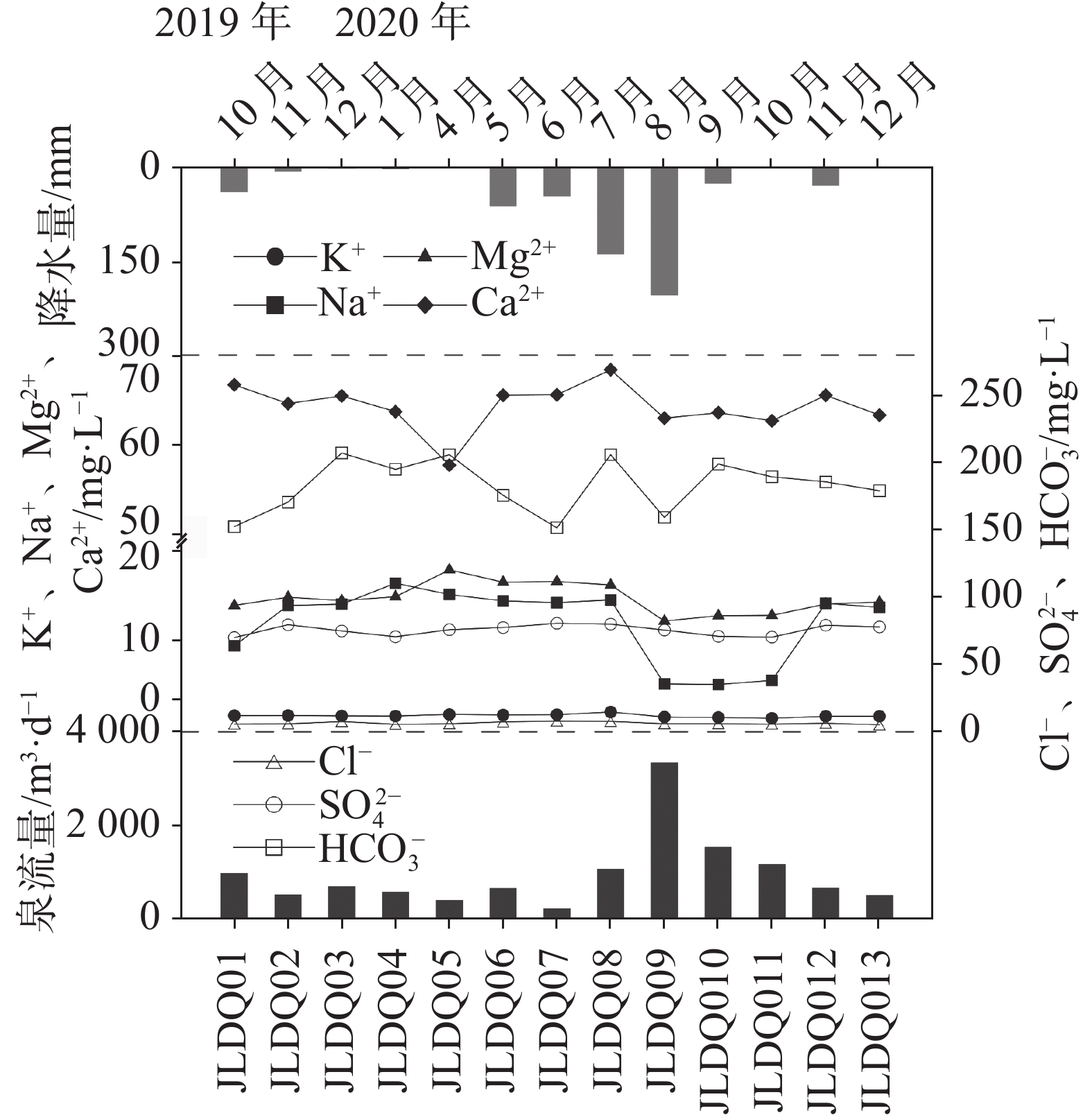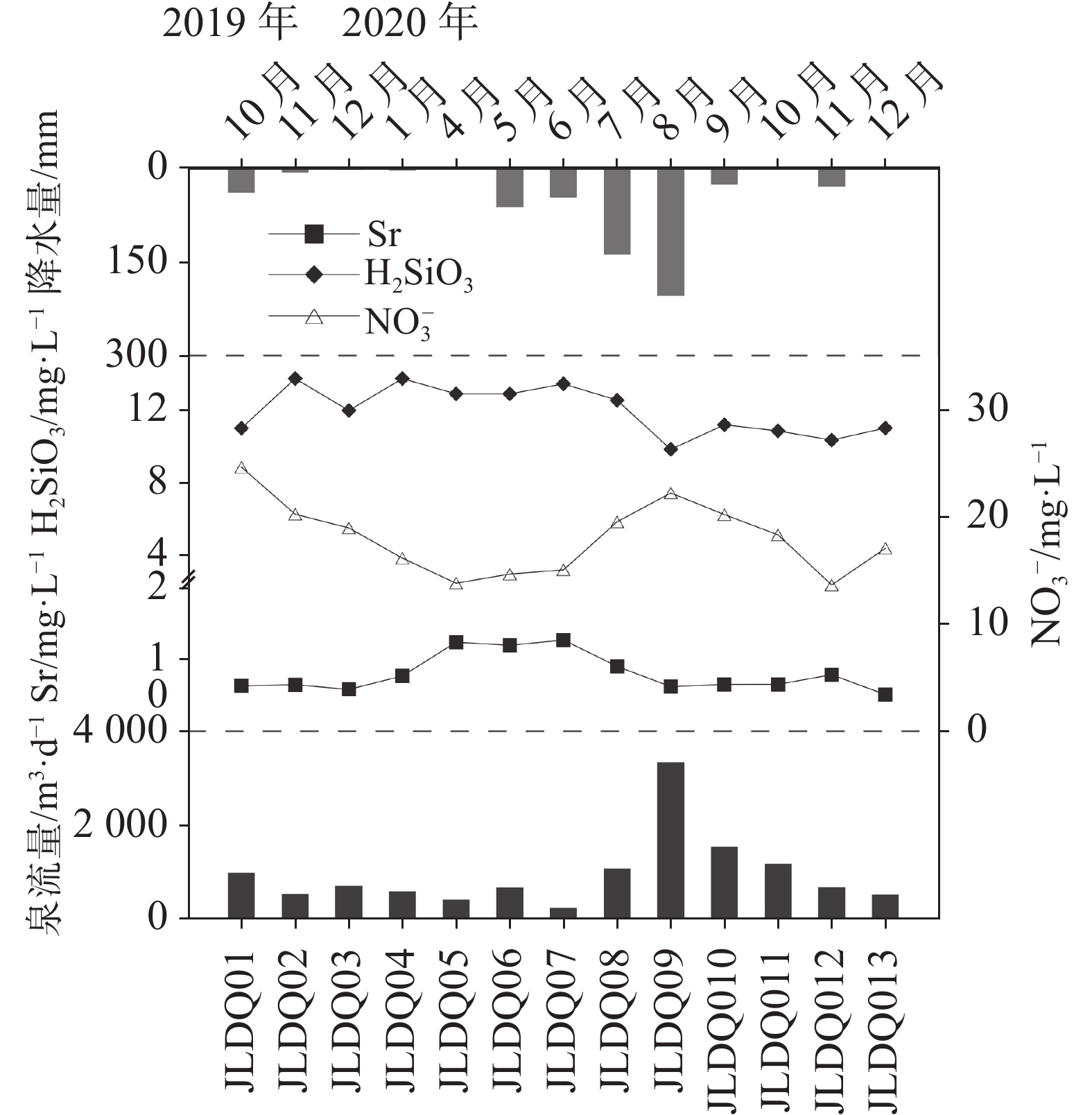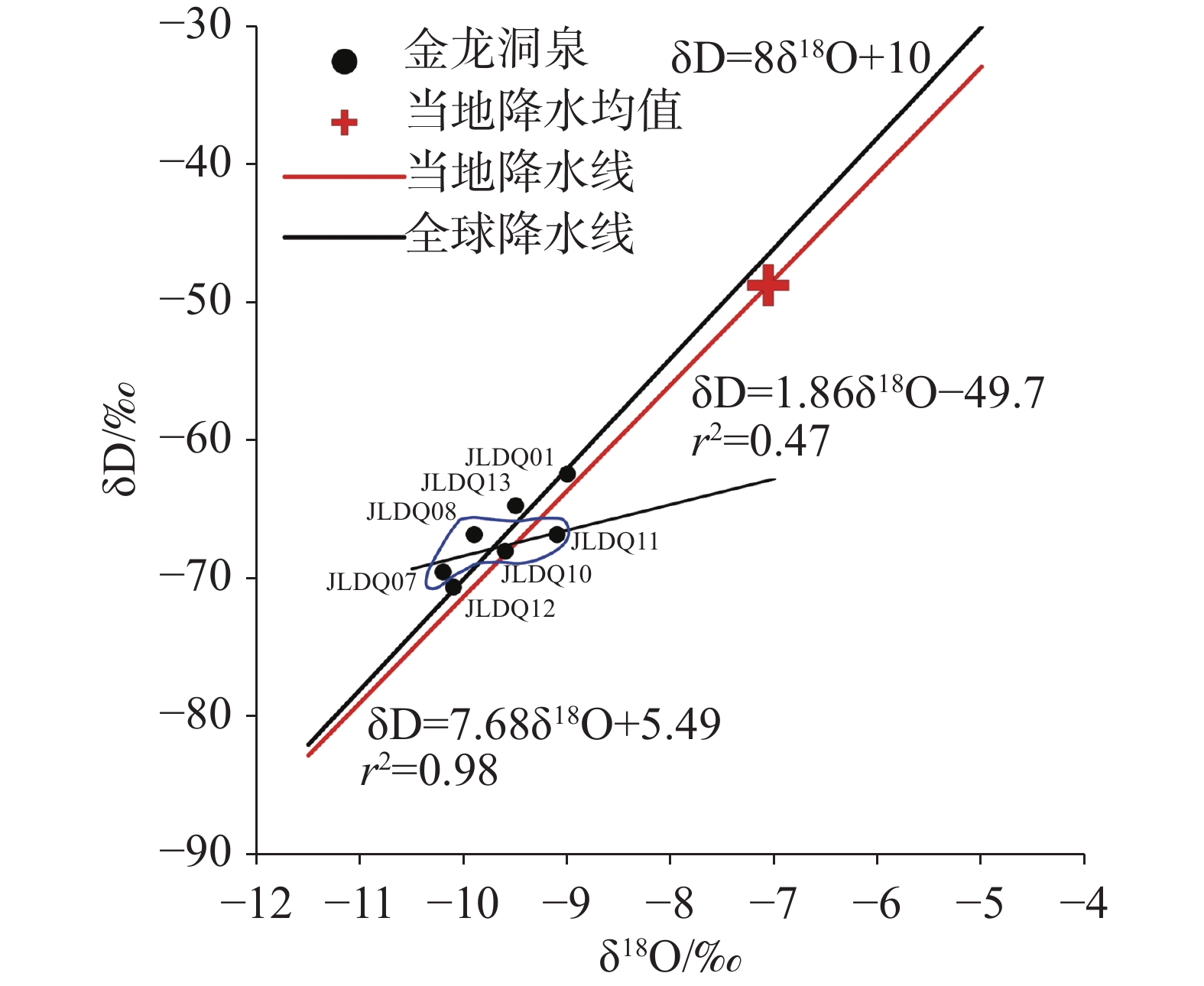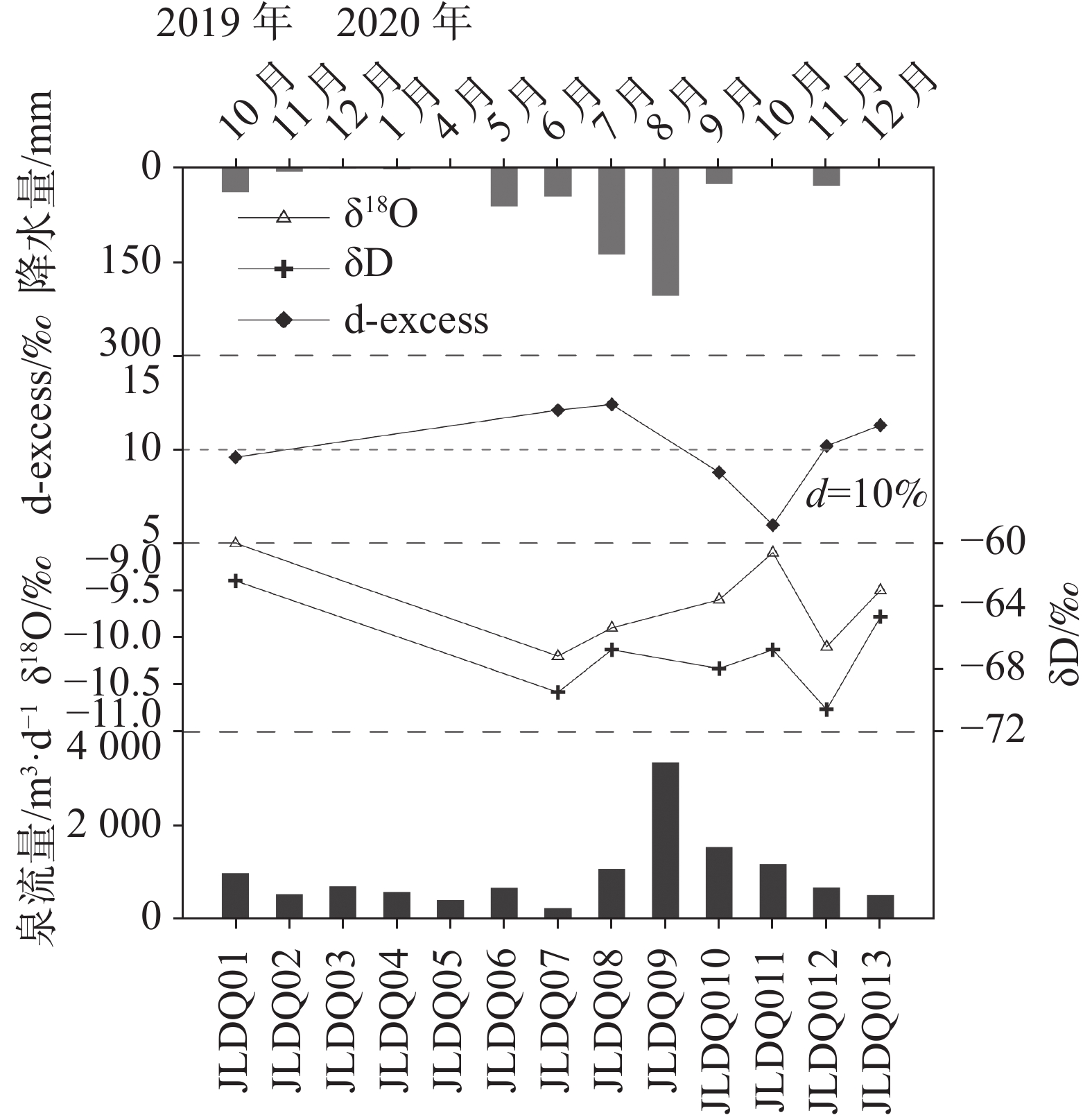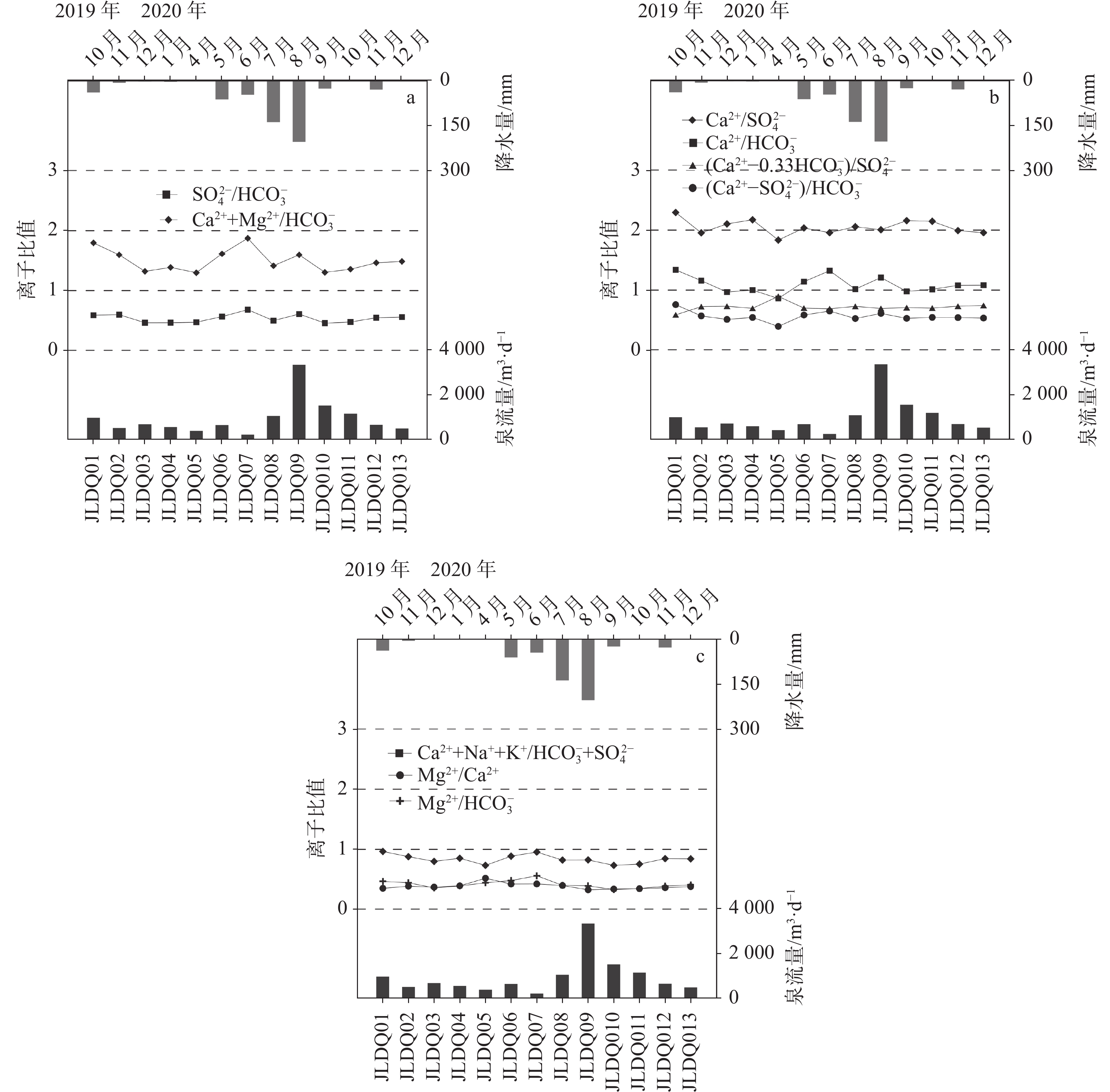Dynamic analysis of hydrochemistry and isotope of the karst spring of Jinlong Cave in the northern section of Taihang Mountains
-
摘要:
以太行山北段金龙洞岩溶泉为研究对象,通过数理统计、离子比值及饱和指数等方法,分析泉水水化学和同位素动态特征、水中主要离子来源及演化、水–岩相互作用过程等内容。结果显示:(1)金龙洞泉补给来源为大气降水,泉流量对其响应程度高,泉流量较小时,水中主要离子含量相对高,水化学类型为HCO3 · SO4-Ca·Mg型,泉流量大时,水中离子含量低,水化学类型为HCO3-Ca、HCO3·SO4-Ca型,泉流量增加引起的稀释作用对离子含量影响明显;(2)控制泉水水化学特征的主要因素为溶滤作用和稀释作用,且Ca2+、Mg2+、
${\rm{HCO}}_3^{-}$ ${\rm{SO}}_4^{2-}$ ${\rm{NO}}_3^{-}$ Abstract:Karst groundwater is an important part of the groundwater system and one of the important resources to ensure human survival and development. The study area is located in the northern part of Taihang Mountains in the west of Baoding City, Hebei Province. The spring water samples were collected monthly in Jinlong Cave, and their dynamic characteristics of hydrochemistry and isotope were analyzed. The study area presents a low-middle mountain landform with erosive structure and warm temperate semi-arid climate. It is a volcano-sedimentary basin with complex geological and structural conditions, which is one of the typical representatives of the thrust nappe structure in the north-central section of Taihang Mountains. The caprock is exposed in a large area. And the strata are well developed with Precambrian, Cambrian, Ordovician, Carboniferous Benxi Formation and Jurassic strata from the bottom to the top. The lithology is mainly composed of dolomite, limestone, shale and andesite. The Fupingian gneiss, in fault contact with the caprock, is exposed around the sedimentary rock mass. The main water-bearing rock formations are medium-thick limestone and dolomite of the middle and upper Ordovician Majiagou formation, Yeli formation and Liangjiashan formation, and limestone of the upper Cambrian Gushan formation. The groundwater type is the fissure water in exposed carbonate karst cave.
Through the analysis of spring water samples and spring flow monitoring data, the change of spring flow is basically synchronized with the change of precipitation, indicating that the local precipitation is the main source of supply for the spring. According to the flow monitoring data, the response of spring flow to precipitation lags 14-50 days. The main ion concentration in the spring, the spring flow and precipitation all experience changes in different degrees. Generally speaking, the concentration of each ion in the spring water is relatively low at the period of concentrated precipitation (July and August). However, it is opposite in other periods that the concentration of each ion in water is relatively high with different fluctuation ranges in different periods. In a word, the main controlling factors of the chemical characteristics of spring water are leaching and dilution. In addition, trace elements such as Sr and
${\rm{NO}}_3^{-}$ ${\rm{NO}}_3^{-}$ ${\rm{SO}}_4^{2-}$ ${\rm{HCO}}_3^{-}$ ${\rm{SO}}_4^{2-}$ -

-
表 1 金龙洞泉流量及水化学组分
Table 1. Spring flow and hydrochemical parameters in Jinlong Cave
样品
编号取样
日期水温/
℃当月降
水量/mm流量/
m3·h−1pH Ec/
μs·cm-1TDS Na+ K+ Ca2+ Mg2+ 
Cl− 

Sr H2SiO3 mg·L−1 JLDQ01 2019.9.23 13.8 38.6 973.9 7.76 490.0 279.92 9.50 1.75 66.72 13.98 152.34 5.42 69.79 24.60 0.63 11.00 JLDQ02 2019.11.21 12.6 6.2 521.3 7.83 525.0 285.75 13.98 1.77 64.65 14.90 170.62 5.55 79.40 20.20 0.65 13.74 JLDQ03 2019.12.12 13.1 1.6 693.7 7.70 450.0 300.33 14.12 1.73 65.49 14.52 207.18 7.24 74.72 18.92 0.58 11.98 JLDQ04 2020.1.14 13.3 2.4 568.8 7.85 388.0 273.76 16.46 1.71 63.74 14.95 194.99 5.24 70.41 16.11 0.77 13.74 JLDQ05 2020.4.23 13.4 0.4 398.9 7.32 506.0 290.83 15.20 1.88 57.80 17.94 205.93 5.59 75.69 13.77 1.25 12.89 JLDQ06 2020.5.18 14.0 61.6 655.2 7.61 513.0 297.16 14.49 1.83 65.57 16.57 175.65 7.02 77.31 14.63 1.20 12.89 JLDQ07 2020.6.16 13.7 46.0 224.3 7.80 517.0 295.08 14.30 1.85 65.62 16.65 151.42 7.60 80.46 15.02 1.28 13.45 JLDQ08 2020.7.16 14.7 137.8 1061.1 7.46 513.3 311.07 14.59 2.16 68.39 16.26 205.93 7.40 79.81 19.49 0.91 12.55 JLDQ09 2020.8.22 14.7 203.5 3330.0 7.29 437.7 264.89 5.27 1.59 63.02 12.25 159.16 5.60 75.39 22.19 0.62 9.83 JLDQ10 2020.9.28 14.2 25.3 1524.6 7.58 447.0 279.20 5.20 1.55 63.63 12.85 198.95 5.60 70.74 20.17 0.65 11.19 JLDQ11 2020.10.18 13.5 0.0 1160.2 8.00 400.8 264.50 5.67 1.46 62.73 12.89 189.45 5.38 70.12 18.28 0.65 10.85 JLDQ12 2020.11.20 13.4 28.7 663.1 7.90 499.0 287.04 14.22 1.68 65.56 14.14 185.69 5.99 79.00 13.61 0.79 10.34 JLDQ13 2020.12.14 13.4 0.4 501.6 7.91 474.0 282.30 13.77 1.68 63.36 14.36 179.05 4.86 77.71 17.03 0.51 11.01 表 2 金龙洞泉同位素测试数据
Table 2. Isotopic data of the spring in Jinlong Cave
样品编号 取样时间 δ18OVSMOW/‰ δDVSMOW/‰ d-excess δ34S /‰ 87Sr/86Sr JLDQ01 2019.10.14 −9.0 −62.4 9.6 −0.5 0.710197 JLDQ07 2020.6.16 −10.2 −69.5 12.1 JLDQ08 2020.7.16 −9.9 −66.8 12.4 JLDQ10 2020.9.28 −9.6 −68.0 8.8 JLDQ11 2020.10.18 −9.1 −66.8 6.0 JLDQ12 2020.11.20 −10.1 −70.6 10.2 JLDQ13 2020.12.14 −9.5 −64.7 11.3 -
[1] 王焰新, 马腾, 郭清海, 马瑞. 地下水与环境变化研究[J]. 地学前缘, 2005, 12(A1):14-21. doi: 10.3321/j.issn:1005-2321.2005.z1.003
WANG Yanxin, MA Teng, GUO Qinghai, MA Rui. Groundwater and environmental change[J]. Earth Science Frontiers, 2005, 12(A1):14-21. doi: 10.3321/j.issn:1005-2321.2005.z1.003
[2] 梁永平, 赵春红. 中国北方岩溶水功能[J]. 中国矿业, 2018, 27(A2):297-299. doi: 10.12075/j.issn.1004-4051.2018.S2.078
LIANG Yongping, ZHAO Chunhong. Karst water function in Northern China[J]. China Mining Magazine, 2018, 27(A2):297-299. doi: 10.12075/j.issn.1004-4051.2018.S2.078
[3] 徐永新, 张志祥, 张永波, 梁永平, 曹建华, 蒋忠诚. 山西岩溶泉研究进展与前瞻[J]. 太原理工大学学报, 2017, 48(3):413-426. doi: 10.16355/j.cnki.issn1007-ji9432tyut.2017.03.020
XU Yongxin, ZHANG Zhixiang, ZHANG Yongbo, LIANG Yongping, CAO Jianhua, JIANG Zhongcheng. Research advance in karst springs of Shanxi Province[J]. Journal of Taiyuan University of Technology, 2017, 48(3):413-426. doi: 10.16355/j.cnki.issn1007-ji9432tyut.2017.03.020
[4] 何娇月, 王金贵, 申宗义, 郭彬, 陈圆圆, 季虹, 张立国, 张鹏程. 太行山中北段神仙山逆冲推覆构造发展与演化[J]. 中国地质调查, 2020, 7(3):75-81.
HE Jiaoyue, WANG Jingui, SHEN Zongyi, GUO Bin, CHEN Yuanyuan, JI Hong, ZHANG Liguo, ZHANG Pengcheng. Development and evolution of Shenxian Mountains overthrust nappe structure in the middle and north section of Taihang Mountains[J]. Geological Survey of China, 2020, 7(3):75-81.
[5] 孙钰霞, 李林立, 魏世强. 喀斯特槽谷区表层喀斯特水化学的暴雨动态特征[J]. 山地学报, 2012, 30(5):513-520. doi: 10.3969/j.issn.1008-2786.2012.05.003
SUN Yuxia, LI Linli, WEI Shiqiang. Dynamic characteristics of surface karst hydrochemistry and heavy rain in karst valley[J]. Mountain Research, 2012, 30(5):513-520. doi: 10.3969/j.issn.1008-2786.2012.05.003
[6] 原雅琼, 孙平安, 苏钊, 于奭, 钟丽华, 何师意, 徐茜. 岩溶流域洪水过程水化学动态变化及影响因素[J]. 环境科学, 2019, 40(11):2143-2151. doi: 10.13227/j.hjkx.201905022
YUAN Yaqiong, SUN Pingan, SU Zhao, YU Shi, ZHONG Lihua, HE Shiyi, XU Qian. Dynamic changes in hydrochemical characteristics and influencing factors in the karst watershed flood process[J]. Environmental Science, 2019, 40(11):2143-2151. doi: 10.13227/j.hjkx.201905022
[7] 李学礼, 孙占学, 刘金辉. 水文地球化学(第三版)[M]. 北京: 原子能出版社, 2010.
LI Xueli, SUN Zhanxue, LIU Jinhui. Hydrogeochemistry(third edition)[M]. Beijing: Atomic Energy Press, 2010.
[8] 吴锡松, 张强, 姜光辉, 郭芳, 吴华英, 骆俊晖. 桂林甑皮岩岩溶地下水硝酸盐来源与转化[J]. 中国岩溶, 2020, 39(2):164-172.
WU Xisong, ZHANG Qiang, JIANG Guanghui, GUO Fang, WU Huaying, LUO Junhui. Sources and transformation of nitrate in karst groundwater of Zengpiyan site, Guilin[J]. Carsologica Sinica, 2020, 39(2):164-172.
[9] 隋海波, 康凤新, 李常锁, 韩建江, 邢丽亭. 水化学特征揭示的济北地热水与济南泉水关系[J]. 中国岩溶, 2017, 36(1):49-58. doi: 10.11932/karst20170106
SUI Haibo, KANG Fengxin, LI Changsuo, HAN Jianjiang, XING Liting. Relationship between north Ji'nan geothermal water and Ji'nan spring water revealed by hydrogeochemical characteristics[J]. Carsologica Sinica, 2017, 36(1):49-58. doi: 10.11932/karst20170106
[10] 马转转. 兰州市南北两山土壤水氢氧稳定同位素动态变化特征及对降水的响应研究[D]. 兰州: 西北师范大学, 2020.
MA Zhuanzhuan. Dynamic change characteristics of stable hydrogen and oxygen isotopes in soil water at the north and south mountains of Lanzhou City and its response to precipitation[D]. Lanzhou: Northwest Normal University, 2020.
[11] 吴秀杰. 氢氧同位素指示沙漠地下水来源研究: 以巴丹吉林沙漠为例[D]. 北京: 中国地质大学(北京), 2018.
WU Xiujie. Hydrogen and oxygen isotopes indicate the source of desert groundwater: A case study of Badain Desert[D]. Beijing: China University of Geosciences(Beijing), 2018.
[12] 吴月. 巴丹吉林沙漠地下水同位素特征与地下水年龄研究[D]. 兰州: 兰州大学, 2014.
WU Yue. Study on isotopic characteristics and age of groundwater in Badain Desert[D]. Lanzhou: Lanzhou University, 2014.
[13] 钱会, 马致远. 水文地球化学[M]. 北京: 地质出版社, 2006.
QIAN Hui, MA Zhiyuan. Hydrogeochemistry[M]. Beijing: Geology Press, 2006.
[14] 苏春利, 张雅, 马燕华, 刘文波. 贵阳市岩溶地下水水化学演化机制: 水化学和锶同位素证据[J]. 地球科学, 2019, 44(9):2829-2838.
SU Chunli, ZHANG Ya, MA Yanhua, LIU Wenbo. Hydrochemical evolution processes of karst groundwater in Guiyang City: Evidences from hydrochemistry and 87Sr/86Sr ratios[J]. Earth Science, 2019, 44(9):2829-2838.
[15] 胡进武, 王增银, 周炼, 刘文波. 岩溶水锶元素水文地球化学特征[J]. 中国岩溶, 2004, 23(1):37-42. doi: 10.3969/j.issn.1001-4810.2004.01.007
HU Jinwu, WANG Zengyin, ZHOU Lian, LIU Wenbo. Hydrogeochemical characteristics of the strontium in karst water[J]. Carsologica Sinica, 2004, 23(1):37-42. doi: 10.3969/j.issn.1001-4810.2004.01.007
[16] 唐金平, 张强, 胡漾, 邵江, 何文君, 张宇. 巴中北部岩溶山区地下水化学特征及演化分析[J]. 环境科学, 2019, 40(10):4543-4552. doi: 10.13227/j.hjkx.201904068
TANG Jinping, ZHANG Qiang, HU Yang, SHAO Jiang, HE Wenjun, ZHANG Yu. Hydrochemical characteristics of karst groundwater in the mountains of northern Bazhong City, China[J]. Environmental Science, 2019, 40(10):4543-4552. doi: 10.13227/j.hjkx.201904068
[17] 徐森, 李思亮, 钟君, 苏靖, 陈率. 赤水河流域水化学特征与岩石风化机制[J]. 生态学杂志, 2018, 37(3):667-678. doi: 10.13292/j.1000-4890.201803.031
XU Sen, LI Siliang, ZHONG Jun, SU Jing, CHEN Shuai. Hydrochemical characteristics and chemical weathering processes in Chishui River Basin[J]. Chinese Journal of Ecology, 2018, 37(3):667-678. doi: 10.13292/j.1000-4890.201803.031
[18] 王攀, 靳孟贵, 路东臣. 河南省永城市浅层地下水化学特征及形成机制[J]. 地球科学, 2020, 45(6):2232-2244.
WANG Pan, JIN Menggui, LU Dongchen. Hydrogeochemistry characteristics and formation mechanism of shallow groundwater in Yongcheng City, Henan Province[J]. Earth Science, 2020, 45(6):2232-2244.
[19] 王瑞, 李潇瀚. 百泉泉域岩溶地下水水化学演化特征及成因[J]. 中国岩溶, 2021, 40(3):398-408.
WANG Rui, LI Xiaohan. Hydrochemical characteristics and genesis of karst groundwater in the Baiquan spring catchment[J]. Carsologica Sinica, 2021, 40(3):398-408.
[20] 袁建飞, 邓国仕, 徐芬, 唐业旗, 李鹏岳. 毕节市北部岩溶地下水水文地球化学特征[J]. 水文地质工程地质, 2016, 43(1):12-21. doi: 10.16030/j.cnki.issn.1000-3665.2016.01.03
YUAN Jianfei, DENG Guoshi, XU Fen, TANG Yeqi, LI Pengyue. Hydrogeochemical characteristics of karst groundwater in the northern part of the city of Bijie[J]. Hydrogeology & Engineering Geology, 2016, 43(1):12-21. doi: 10.16030/j.cnki.issn.1000-3665.2016.01.03
[21] R Umar, A Absa. Chemical characteristics of groundwater in parts of the Gambhir River basin, Bharatpur District, Rajasthan, India[J]. Environmental Geology, 2003, 44(5): 535-544.
[22] 卢丽, 陈余道, 邹胜章, 樊连杰, 林永生, 王喆. 岩溶区典型工业型城市地下水水化学特征及成因机制[J]. 中国岩溶, 2022, 41(4):588-598.
LU Li, CHEN Yudao, ZOU Shengzhang, FAN Lianjie, LIN Yongsheng, WANG Zhe. Hydrochemical characteristics and genetic mechanism of groundwater in typical industrial cities in karst areas[J]. Carsologica Sinica, 2022, 41(4):588-598.
[23] N Subba Rao. Geochemistry of groundwater in parts of Guntur district, Andhra Pradesh, India[J]. Environmental Geology, 2002, 41(5):535-544.
[24] 刘再华, Chris Groves, 袁道先, Joe Meiman, 姜光辉, 何师意. 水−岩−气相互作用引起的水化学动态变化研究: 以桂林岩溶试验场为例[J]. 水文地质工程地质, 2003, 30(4):13-18. doi: 10.3969/j.issn.1000-3665.2003.04.003
LIU Zaihua, Chris Groves, YUAN Daoxian, Joe Meiman, JIANG Guanghui, HE Shiyi. Study on the hydrochemical variations caused by the water-rock-gas interaction: An example from the Guilin karst experimental site[J]. Hydrogeology & Engineering Geology, 2003, 30(4):13-18. doi: 10.3969/j.issn.1000-3665.2003.04.003
-











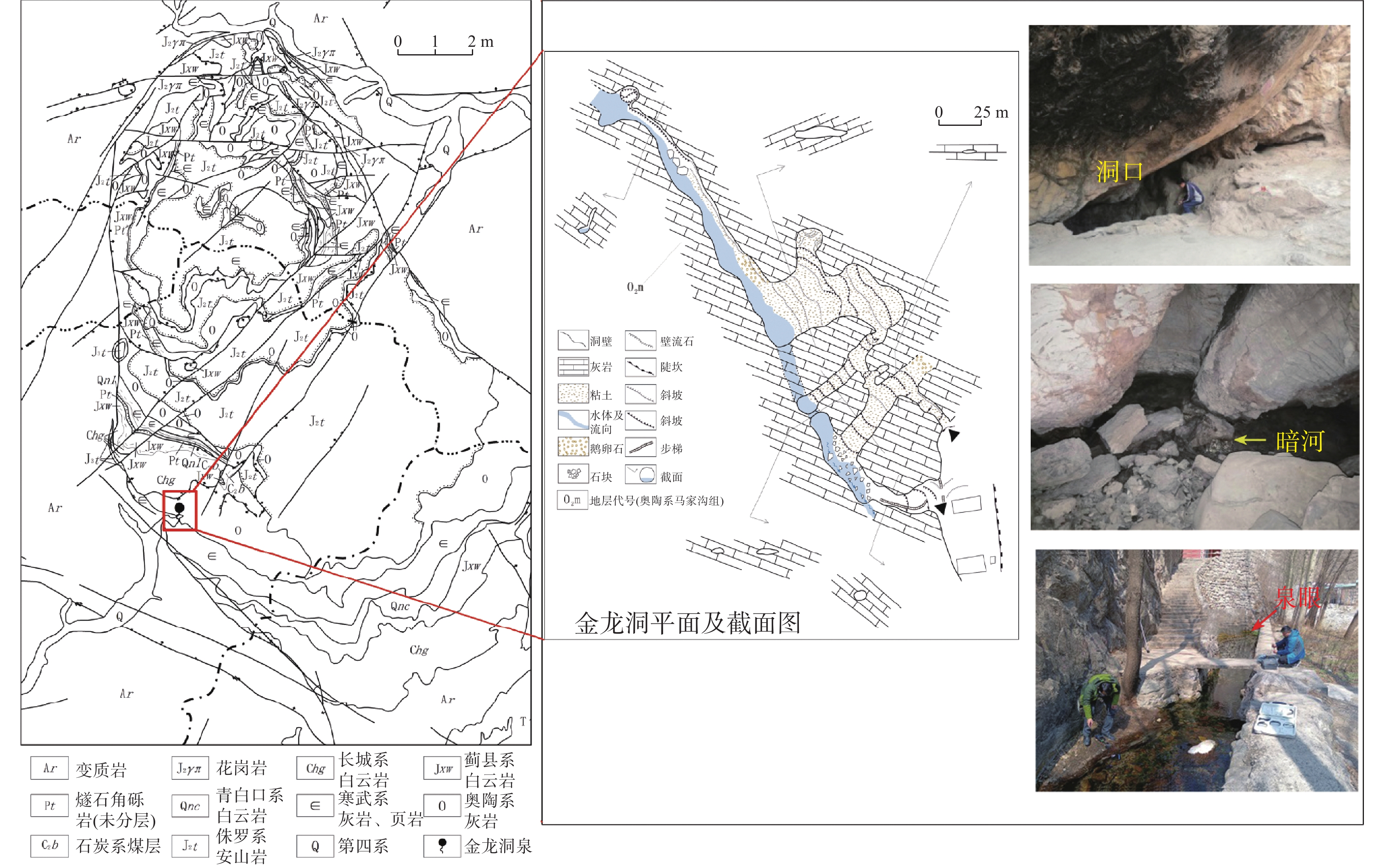
 下载:
下载:
